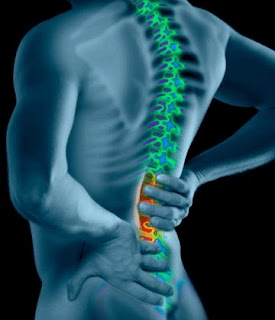Facet joint syndrome is the pain at the joint between two vertebrae in your spine, another term for facet joint syndrome is osteoarthritis. The joints in your spine that make your back flexible and enable you to bend and twist are the facet joints.The nerves in your back exit your spinal cord through these joints on their way to other parts of your body. Normal healthy facet joints have cartilage, which allows your vertebrae to move smoothly against each other with no grinding. All your joints are lubricated with synovial fluid for additional protection against wear and tear.
Another term for facet joint syndrome is facet arthropathy. Progressive and degenerative changes in the spine may cause body weight to shift unevenly to the facet joints. The resulting extra stress causes wear and tear on the joint and changes it over time. Through this process the joint capsule thins and smooth cartilage breaks down and becomes irregular. Bone spurs may also form. These changes make it difficult for the joint to move fluidly and it reacts by becoming inflamed and irritated, similar to arthritis of the knee joint. As a result this irritated joint sends pain signals to the brain via small nerves in the capsule called medial branch sensory nerves. When this happens the muscles in the area can stiffen and spasm.
Until an event triggers symptoms facet joint degeneration can be painless. Indicators that a person’s pain is coming from the facet joints may include a diffuse, dull ache in the low back directly over the spine that can spread to the buttocks. It can be felt in the shoulders and back of the skull, as well as in the neck. Twisting backwards or bending sideways towards the affected joint will cause pain. Periods of inactivity or standing may worsen the pain. Sitting, leaning forward, or changing positions, activities that take the weight off the joint, may ease the pain. A patient's facet joint symptoms can also mimic the pain of a disc herniation. In the event that bone spurs form and press on the spinal nerves, pain may be felt down the arms or legs. The pain may come in periodic flare-ups, or it may be chronic.
Cartilage in our joints wears down as we get older. Spine conditions that change the way the facet joints align and move can cause pain, events such as an injury, repetitive movements, obesity, and poor posture. The deterioration of a vertebral disc can begin changes in the facet joints. Over time when the load of the body weight shifts to the facet joint, the cartilage breaks down, the joint space narrows, and the bones rub together, leading to complications. Those prone to arthritis, both men and women, may be affected by facet joint syndrome. Usually it targets those between the ages of 40 and 70 and can also develop in people who have had a spine injury.
A complete history and physical exam usually begins the diagnosis of facet joint syndrome. Other diagnostic tests may be ordered by your doctor as well. To determine whether there are abnormalities in your spine, X-rays may be recommended. Sometimes a CT scan can show more detail about your facet joint surfaces. Your doctor may recommend a CT scan to get a better look if the X-rays suggest something may be affecting your facet joints. Your doctor may order a bone scan which can be useful in determining whether your facet joints are inflamed. In most cases an inflamed facet joint will show up as a hot spot on a bone scan.
There is evidence that exercise, lifestyle changes and careful management of your back pain can contribute to better quality of life even though facet joint arthritis cannot be reversed. Your doctor may recommend injections, medications or surgery if conservative therapies fail to help you manage and control the pain. To prevent painful episodes using correct posture and keeping your spine in alignment are important things you can do. You can reduce the load on the facet joints and alleviate pain by losing weight and you might benefit further by making adjustments to your daily standing, sitting, and sleeping habits.
Your doctor will likely recommend physical therapy to treat your symptoms once a diagnosis of facet joint syndrome has been confirmed. Well-rounded rehabilitation programs assist in improving your mobility and strength, helping you do your daily activities with greater ease and ability, and calming pain and inflammation. To decrease blood flow to the affected area and reduce swelling, physical therapy may also include the use of ice. To treat muscle spasms ultrasound and electrostimulation may also be used. Exercises will help you regain joint mobility, flexibility, and strength When you're feeling better and muscle stretching and massage may also be helpful.
In most cases you can heal faster through physical therapy, and exercise is very helpful for a painful facet joint. To strengthen and stretch your lower back, leg, and stomach muscles physical therapists will work with you. These specialists can instruct you on proper lifting and walking techniques. You must follow through, though...a physical therapist may show you strengthening and stretching exercises, but it is your responsibility to follow them.
In some cases patients could require topical patches, oral anti-inflammatory medications or creams, salves or mechanical bracing. For muscle spasms, sometimes muscle relaxers are prescribed. A minimally invasive procedure that involves an injection of a corticosteroid and an analgesic-numbing agent into the painful joint is a facet joint injection, and steroids can reduce the swelling and inflammation of the nerves.
Medicine. Matt Ota is a Board Certified Physician Assistant with
extensive knowledge of musculoskeletal disorders and injuries.







